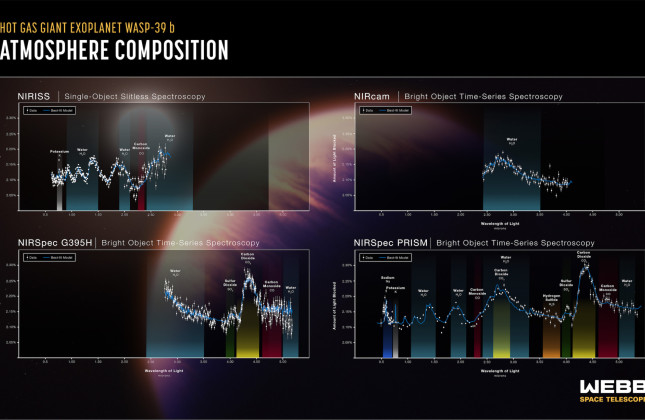The results concern the atmosphere of the "hot Saturn" WASP-39 b, a planet about the same weight as Saturn orbiting a star about 700 light years from Earth. While Webb and other space telescopes, including Hubble and Spitzer, have previously revealed isolated ingredients of this hot planet's atmosphere, the new measurements with the highly sensitive instruments on Webb provide a full inventory of atoms, molecules and even signs of active chemistry and clouds. The latest data also give an idea of what these clouds look like up close: fractured rather than a single, even blanket over the planet.
"We observed the exoplanet with multiple instruments that together cover a broad band of the infrared spectrum and a large number of chemical fingerprints that were inaccessible until Webb's arrival," said research coordinator Natalie Batalha, an astronomer at the University of California at Santa Cruz, California, USA. UvA astronomer Jean-Michel Desert, a member of the Science Council of these first results, adds, "This will completely change the field of exoplanet research. We can now observe the spectral fingerprints of the chemical composition of the atmosphere of exoplanets in an unambiguous and comprehensive way as never before."
One of the extraordinary findings is the first observation in the atmosphere of an exoplanet of sulfur dioxide, a molecule produced by chemical reactions triggered by high-energy light from the planet's parent star. On Earth, the protective ozone layer in the upper atmosphere is formed in a similar way. Leiden astronomer Yamila Miguel, who made models of the atmosphere of WASP-39 b, including the photochemistry used to explain the origin of sulfur dioxide, sees JWST as a turning point in her field: "This is the first time we have seen concrete evidence of photochemistry - chemical reactions initiated by energetic starlight - on exoplanets." This led to another first: scientists applied computer models of photochemistry to data that require this higher level of physics to be fully explained. These improved models will help build the technological knowledge to interpret possible signs of life in the future.

The James Webb Space Telescope identified sulfur dioxide in the atmosphere of an exoplanet for the first time. Its presence can only be explained by photochemistry - chemical reactions initiated by high-energy starlight particles. Credit: NASA/JPL-Caltech/Robert Hurt; Center for Astrophysics-Harvard & Smithsonian/Melissa Weiss
WASP-39 b has an estimated temperature of 900 degrees Celsius and an atmosphere composed mainly of hydrogen. The exoplanet will almost certainly not be able to support life. But the new results may guide evidence for potential life on other exoplanets, such as those of the smaller, rocky planets in the TRAPPIST-1 system.
The planet's proximity to its star - the planet is eight times closer to its star than Mercury is to our sun - makes it a laboratory for studying the effects of radiation from stars on exoplanets. A better knowledge of the star-planet relationship should lead to a better understanding of the diversity of planets in our Milky Way.
Other constituents in the atmosphere discovered by the Webb telescope include sodium, potassium and water vapor, confirming previous observations from telescopes in space and on the ground. It also found additional signals of water at longer wavelengths not previously observed. Webb also saw carbon dioxide at higher resolution, providing twice as much data as previous observations. While carbon monoxide was also observed, the Webb data lack clear signs of both methane and hydrogen sulfide.
Capturing such a broad spectrum of WASP-39 b's atmosphere was a scientific tour de force: an international team of hundreds of people independently analyzed data from instruments on the Webb telescope. Webb views the universe in infrared light, beyond the region in the electromagnetic spectrum that the human eye can perceive. This allows the telescope to pick up chemical fingerprints that cannot be detected in visible light. The three instruments used are NIRSpec, NIRCam and NIRISS.
To see the light from WASP-39 b, Webb followed the planet as it passed in front of its star, filtering some of the star's light through the planet's atmosphere. Different types of molecules in the atmosphere absorb different colors of the starlight spectrum, so the colors that are missing tell astronomers which molecules are present.
The now-discovered complete inventory of chemical ingredients also gives scientists a glimpse into the abundance of different elements in relation to each other, such as the carbon-oxygen or potassium-oxygen ratio. That, in turn, provides insight into how this planet formed in its early years from the disc of gas and dust around its parent star. The chemical inventory of WASP-39 b indicates a history of collisions and clumping of smaller chunks, called planetesimals, that eventually created a giant planet. The abundance of sulfur relative to hydrogen indicates that the planet presumably experienced a significant accretion of planetesimals that were able to supply these ingredients to the atmosphere. Oxygen is also much more abundant in the atmosphere than carbon. This possibly indicates that WASP-39 b originally formed far from its central star.
Other co-authors working in the Netherlands are Hinna Shivkumar and Saugata Barat of the University of Amsterdam and Amy Louca of the Leiden Observatory. Amy Louca: "As a PhD student, it was great to work with this data and be able to reproduce signatures of carbon dioxide and sulfur dioxide, for example, in the models. It showed us that there are so many different aspects to exoplanets. We are finally able to fit the smaller puzzle pieces together."
Preprints of the scientific papers:
Early Release Science of the exoplanet WASP-39b with JWST NIRSpec G395H (Alderson et al.)
Early Release Science of the exoplanet WASP-39b with JWST NIRSpec PRISM (Rustamkulov et al.)
Early Release Science of the exoplanet WASP-39b with JWST NIRCam (Ahrer et al.)
Early Release Science of the exoplanet WASP-39b with JWST NIRISS (Feinstein et al.)
Direct Evidence of Photochemistry in an Exoplanet Atmosphere (Tsai et al.)
